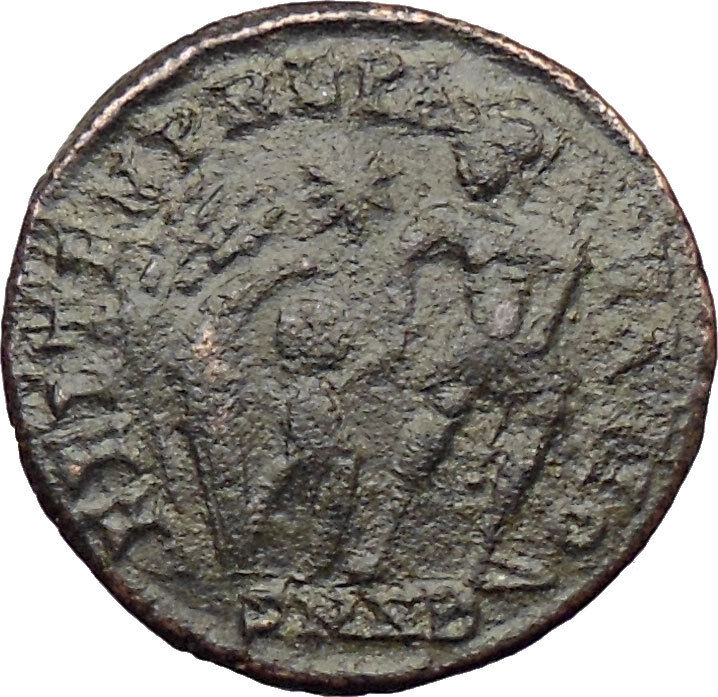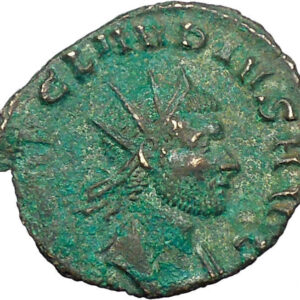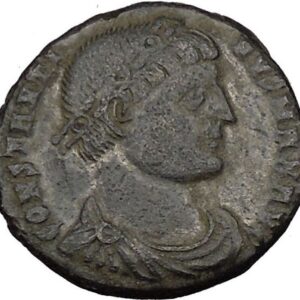|
Gratian – Roman Emperor: 367-383 A.D.
Bronze AE3 16mm (2.40 grams) Constantinople mint, struck 367-375 A.D.
Reference: Rare, possibly unpublished
DN GRATIANVS P F AVG, Pearl-diademed, draped and cuirassed bust right.
GLORIA ROMANORVM Exe: CONSΓ – Gratian advancing right, dragging captive and holding labarum topped with Chi-Rho; two crosses across fields.
* Numismatic Note: This is a very rare type which features two crosses in the fields.
You are bidding on the exact item pictured, provided with a Certificate of Authenticity and Lifetime Guarantee of Authenticity.
 The labarum was a vexillum (military standard) that displayed the “Chi-Rho” symbol ☧, a christogram formed from the first two Greek letters of the word “Christ” (Greek: ΧΡΙΣΤΟΣ, or Χριστός) — Chi (χ) and Rho (ρ). It was first used by the Roman emperor Constantine I. Since the vexillum consisted of a flag suspended from the crossbar of a cross, it was ideally suited to symbolize the crucifixion of Christ. The labarum was a vexillum (military standard) that displayed the “Chi-Rho” symbol ☧, a christogram formed from the first two Greek letters of the word “Christ” (Greek: ΧΡΙΣΤΟΣ, or Χριστός) — Chi (χ) and Rho (ρ). It was first used by the Roman emperor Constantine I. Since the vexillum consisted of a flag suspended from the crossbar of a cross, it was ideally suited to symbolize the crucifixion of Christ.
Ancient sources draw an unambiguous distinction between the two terms “labarum” and “Chi-Rho”, even though later usage sometimes regards the two as synonyms. The name labarum was applied both to the original standard used by Constantine the Great and to the many standards produced in imitation of it in the Late Antique world, and subsequently.
 The Chi Rho is one of the earliest forms of christogram, and is used by some Christians. It is formed by superimposing the first two (capital) letters chi and rho (ΧΡ) of the Greek word “ΧΡΙΣΤΟΣ” = KRistos = Christ in such a way to produce the monogram. Although not technically a Christian cross, the Chi-Rho invokes the authority of Jesus, as well as symbolising his status as the Christ. The Chi Rho is one of the earliest forms of christogram, and is used by some Christians. It is formed by superimposing the first two (capital) letters chi and rho (ΧΡ) of the Greek word “ΧΡΙΣΤΟΣ” = KRistos = Christ in such a way to produce the monogram. Although not technically a Christian cross, the Chi-Rho invokes the authority of Jesus, as well as symbolising his status as the Christ.
The Chi-Rho symbol was also used by pagan Greek scribes to mark, in the margin, a particularly valuable or relevant passage; the combined letters Chi and Rho standing for chrēston, meaning “good.” Some coins of Ptolemy III Euergetes (r. 246–222 BC) were marked with a Chi-Rho.
The Chi-Rho symbol was used by the Roman emperor Constantine I (r. 306–337) as part of a military standard (vexillum), Constantine’s standard was known as the Labarum. Early symbols similar to the Chi Rho were the Staurogram (_I_193_2.jpg/20px-Christliche_Symbolik_(Menzel)_I_193_2.jpg) ) and the IX monogram ( ) and the IX monogram (_I_193_4.jpg/20px-Christliche_Symbolik_(Menzel)_I_193_4.jpg) ). ).
.png/220px-Cross_(PSF).png) The Christian Cross, seen as a representation of the instrument of the crucifixion of Jesus, is the best-known symbol of Christianity. It is related to the crucifix (a cross that includes a usually three-dimensional representation of Jesus’ body) and to the more general family of cross symbols. The basic forms of the cross are the Latin cross (✝) and the Greek cross (✚), with numerous variants used in heraldry and in various confessional contexts. The Christian Cross, seen as a representation of the instrument of the crucifixion of Jesus, is the best-known symbol of Christianity. It is related to the crucifix (a cross that includes a usually three-dimensional representation of Jesus’ body) and to the more general family of cross symbols. The basic forms of the cross are the Latin cross (✝) and the Greek cross (✚), with numerous variants used in heraldry and in various confessional contexts.
Christian cross
Further information: Instrument of Jesus’ crucifixion, Early Christian symbols, Christogram, and Christian cross variants
The shape of the cross (crux, stauros “stake, gibbet”), as represented by the letter T, came to be used as a “seal” or symbol of Early Christianity by the 2nd century. Clement of Alexandria in the early 3rd century calls it τὸ κυριακὸν σημεῖον (“the Lord’s sign”) he repeats the idea, current as early as the Epistle of Barnabas, that the number 318 (in Greek numerals, ΤΙΗ) in Genesis 14:14 was a foreshadowing (a “type”) of the cross (the letter Tau) and of Jesus (the letters Iota Eta). Clement’s contemporary Tertullian rejects the accusation that Christians are crucis religiosi (i.e. “adorers of the gibbet”), and returns the accusation by likening the worship of pagan idols to the worship of poles or stakes. In his book De Corona, written in 204, Tertullian tells how it was already a tradition for Christians to trace repeatedly on their foreheads the sign of the cross.
While early Christians used the T-shape to represent the cross in writing and gesture, the use of the Greek cross and Latin cross, i.e. crosses with intersecting beams, appears in Christian art towards the end of Late Antiquity. An early example of the cruciform halo, used to identify Christ in paintings, is found in the Miracles of the Loaves and Fishes mosaic of Sant’Apollinare Nuovo, Ravenna (6th century). The Patriarchal cross, a Latin cross with an additional horizontal bar, first appears in the 10th century. A wide variation of cross symbols is introduced for the purposes of heraldry beginning in the age of the Crusades.
Gratian (Latin: Flavius Gratianus Augustus; 18 April/23 May 359 – 25 August 383) was Roman emperor from 367 to 383. The eldest son of Valentinian I, during his youth Gratian accompanied his father on several campaigns along the Rhine and Danube frontiers. Upon the death of Valentinian in 375, Gratian’s brother Valentinian II was declared emperor by his father’s soldiers. In 378, Gratian’s generals won a decisive victory over the Lentienses, a branch of the Alamanni, at the Battle of Argentovaria. Gratian subsequently led a campaign across the Rhine, the last emperor to do so, and attacked the Lentienses, forcing the tribe to surrender. That same year, his uncle Valens was killed in the Battle of Adrianople against the Goths – making Gratian essentially ruler of the entire Roman Empire. He favoured Christianity over traditional Roman religion, refusing the divine attributes of the Emperors and removing the Altar of Victory from the Roman Senate.
Life
Gratian was the son of Emperor Valentinian I by Marina Severa, and was born at Sirmium (now Sremska Mitrovica, Serbia) in Pannonia. He was named after his grandfather Gratian the Elder. Gratian was first married to Flavia Maxima Constantia, daughter of Constantius II. His second wife was Laeta. Both marriages remained childless. His stepmother was Empress Justina and his paternal half siblings were Emperor Valentinian II, Galla and Justa.
On 24 August 367 he received from his father the title of Augustus. On the death of Valentinian (17 November 375), the troops in Pannonia proclaimed his infant son (by a second wife Justina) emperor under the title of Valentinian II.
Gratian acquiesced in their choice; reserving for himself the administration of the Gallic provinces, he handed over Italy, Illyricum and Africa to Valentinian and his mother, who fixed their residence at Mediolanum. The division, however, was merely nominal, and the real authority remained in the hands of Gratian.
Gratian’s general Mallobaudes, a king of the Franks, and Naniemus, completely defeated the Lentienses, the southernmost branch of the Alamanni, in May 378 at the Battle of Argentovaria. Upon receiving news of the victory, Gratian personally led a campaign across the Upper Rhine into the territory of the Lentienses. After initial trouble facing the Lentienses on high ground, Gratian blockaded the enemy instead and received their surrender. The Lentienses were forced to supply young men to be levied into the Roman army, while the remainder were allowed to return home. Later that year, Valens met his death in the Battle of Adrianople on 9 August. Valens refused to wait for Gratian and his army to arrive and assist in defeating the host of Goths, Alans and Huns; as a result, two-thirds of the eastern Roman army were killed as well.
In the same year, the government of the Eastern Empire devolved upon Gratian, but feeling himself unable to resist unaided the incursions of the barbarians, he promoted Theodosius I on 19 January 379 to govern that portion of the Empire. Gratianus and Theodosius then cleared the Illyricum of barbarians in the Gothic War (376-382).
For some years Gratian governed the Empire with energy and success but gradually sank into indolence, occupying himself chiefly with the pleasures of the chase, and became a tool in the hands of the Frankish general Merobaudes and bishop St. Ambrose of Milan.
By taking into his personal service a body of Alans, and appearing in public in the dress of a Scythian warrior, after the disaster of the Battle of Adrianople, he aroused the contempt and resentment of his Roman troops. A Roman general named Magnus Maximus took advantage of this feeling to raise the standard of revolt in Britain and invaded Gaul with a large army. Gratian, who was then in Paris, being deserted by his troops, fled to Lyon. There, through the treachery of the governor, Gratian was delivered over to one of the rebel generals, Andragathius, and assassinated on 25 August 383.
Empire and Orthodox Christianity
The reign of Gratian forms an important epoch in ecclesiastical history, since during that period Nicene Christianity for the first time became dominant throughout the empire.
Gratian also published an edict that all their subjects should profess the faith of the bishops of Rome and Alexandria (i.e., the Nicene faith). The move was mainly thrust at the various beliefs that had arisen out of Arianism, but smaller dissident sects, such as the Macedonians, were also prohibited.
Suppression of paganism
Gratian, under the influence of his chief advisor the Bishop of Milan Ambrose, took active steps to repress pagan worship. This brought to an end a period of widespread, if unofficial, religious tolerance that had existed since the time of Julian. “In the long truce between the hostile camps”, writes historian Samuel Dill “the pagan, the sceptic, even the formal, the lukewarm Christian, may have come to dream of a mutual toleration which would leave the ancient forms undisturbed but such men, living in a world of literary and antiquarian illusions, know little of the inner forces of the new Christian movement.”
In 382, Gratian appropriated the income of the Pagan priests and Vestal Virgins, forbade legacies of real property to them and abolished other privileges belonging to the Vestals and to the pontiffs. He confiscated the personal possessions of the colleges of Pagan priests, which also lost all their privileges and immunities. Gratian declared that all of the Pagan temples and shrines were to be confiscated by the government and that their revenues were to be joined to the property of the royal treasury.
He ordered another removal of the Altar of Victory from the Senate House at Rome, despite protests of the pagan members of the Senate, and confiscated its revenues. Pagan Senators responded by sending an appeal to Gratian, reminding him that he was still the Pontifex Maximus and that it was his duty to see that the ancestral Pagan rites were properly performed. They appealed to Gratian to restore the Altar of Victory and the rights and privileges of the Vestal Virgins and priestly colleges. Gratian, at the urging of Ambrose, did not grant an audience to the Pagan Senators. Moreover, he further renounced the title, office, and insignia of the Pontifex Maximus. Notwithstanding his actions, Gratian was still deified after his death.[citation needed]
See also
 Byzantine Empire portal Byzantine Empire portal
- Altar of Victory
- Ambrosius
- Battle of Adrianople
- List of Byzantine emperors
- Magnus Maximus
- Merobaudes
- Theodosius I
- Valens
|





 The labarum was a vexillum (military standard) that displayed the “Chi-Rho” symbol ☧, a christogram formed from the first two Greek letters of the word “Christ” (Greek:
The labarum was a vexillum (military standard) that displayed the “Chi-Rho” symbol ☧, a christogram formed from the first two Greek letters of the word “Christ” (Greek:  The Chi Rho is one of the earliest forms of christogram, and is used by some Christians. It is formed by superimposing the first two (capital) letters chi and rho (ΧΡ) of the Greek word “ΧΡΙΣΤΟΣ” = KRistos = Christ in such a way to produce the monogram. Although not technically a Christian cross, the Chi-Rho invokes the authority of Jesus, as well as symbolising his status as the Christ.
The Chi Rho is one of the earliest forms of christogram, and is used by some Christians. It is formed by superimposing the first two (capital) letters chi and rho (ΧΡ) of the Greek word “ΧΡΙΣΤΟΣ” = KRistos = Christ in such a way to produce the monogram. Although not technically a Christian cross, the Chi-Rho invokes the authority of Jesus, as well as symbolising his status as the Christ. .png/220px-Cross_(PSF).png) The Christian Cross, seen as a representation of the instrument of the crucifixion of Jesus, is the best-known symbol of Christianity. It is related to the crucifix (a cross that includes a usually three-dimensional representation of Jesus’ body) and to the more general family of cross symbols. The basic forms of the cross are the Latin cross (✝) and the Greek cross (✚), with numerous variants used in heraldry and in various confessional contexts.
The Christian Cross, seen as a representation of the instrument of the crucifixion of Jesus, is the best-known symbol of Christianity. It is related to the crucifix (a cross that includes a usually three-dimensional representation of Jesus’ body) and to the more general family of cross symbols. The basic forms of the cross are the Latin cross (✝) and the Greek cross (✚), with numerous variants used in heraldry and in various confessional contexts.




